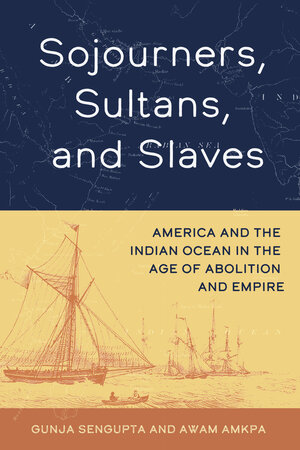The Book
Sojourners, Sultans and Slaves: America and the Indian Ocean in the Age of Abolition and Empire
The Author(s)
Gunja SenGupta and Awam Amkpa

This book claims major innovations and largely fulfils them. It deals with a familiar period in Atlantic World histories, the age of revolution and of fierce contestation over slavery and the future of slave trading. But its aims are to ‘challenge slavery’s hemispheric boundaries’ (xiii) by bringing the Atlantic and Indian Ocean together and to explore realms that American historians have not tapped, the ‘transnational saga of the United States in Indian Ocean World (IOW) contexts of slavery, abolition, and empire’ (22).
In so doing we learn much about the activities of Americans outside the Atlantic, such as Southern overseers attempting to transfer their cotton-farming experiences to British India, New England merchants encountering slavery in Zanzibar and eastern Africa and a Yankee sugar plantation owner in the Comoros. Their experiences highlight the mutual influences and frequent mismatch of Atlantic and IOW concepts of slavery and freedom. This gives insight into American pro-slavery advocates who used examples from British India to stress the benefits of what the authors label ‘proslavery maternalism’ as well as the irony of New England traders who countered their own government in the Civil War era by engaging in what they viewed as differing systems of slavery. IOW examples also gave fuel to abolitionist and free person emphasis on self-sufficiency as a mark of liberty preferring, for example, freedom in Canada to paternalistic support in the Reconstruction South or by a return to Africa.
Another characteristic, especially in the second half of the book, is a determination to present issues through stories of individuals that focus on agency, defined as goals and ambitions outside the framework of slave systems. Many of these stories focus on the experiences and actions of women and children, pieced together from disparate sources. As the authors claim, work on IOW slave trading and slavery rarely provides such voices ‘from below’ and they combine techniques of microhistory analysis and narrative to telling effect.
There are inevitably some limitations in this. The focus on Americans in the IOW, rather than the IOW per se, confines the study to India and the western IOW regions, neglecting the important slave trading networks of southeast Asia and the Islamic world. Some of the analysis is comparative rather than transnational, and links between the American and IOW are not always evident.
The book also tends to treat the IOW as an unknown region for readers, while the Atlantic is the main standard of comparison. For example, it aims to retheorize concepts of agency, diaspora and difference ‘at the heart of African-American studies’ (5). Its originality thus lies in what it shows about American attitudes and experiences rather than what it contributes to IOW slave studies. As the authors recognize, IOW historians have made considerable advances in recent years in demonstrating connections with the Atlantic but this is less recognized in Atlantic World scholarship. This book will certainly help to bridge that gap.
About the Reviewer
Nigel Worden is Emeritus Professor of History at the University of Cape Town. His research focuses on slavery and its aftermath in the Cape Colony in the eighteenth and nineteenth centuries and the connections created by slavery and slave trading across the Indian Ocean. He led a team of researchers on Cape Town’s early history and has published widely in the field of colonial South Africa and its Indian Ocean connections.

0